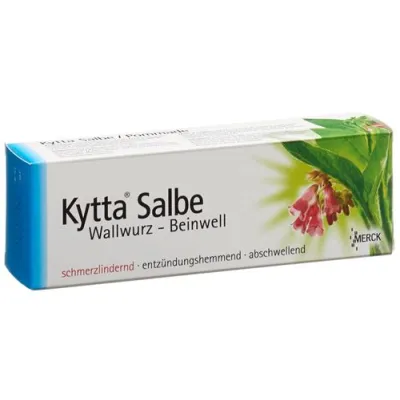kytta ointment
(1 Pages)
Kytta ointment 100 g
Herbal medicineWhat is Kytta ointment and when is it used?Kytta ointment contains an extract made from the fresh roots of Symphytum officinale (common comfrey) using a special process. Kytta ointment has a decongestant, pain-relieving and anti-inflammatory effect. Kytta ointment is non-greasy and non-lubricating and is therefore easy to wash off. Kytta ointment is used externally to support the treatment of degenerative-rheumatoid diseases (e.g. knee arthritis), muscle, joint and nerve pain, and blunt, bloodless injuries such as bruises, strains and sprains. It is also used for tendonitis and, if the doctor recommends it, for the aftercare of bone fractures and dislocations.When should Kytta ointment not be used or should it only be used with caution?Kytta ointment must not be used in case of known hypersensitivity to any of the ingredients (see composition) or in children under 3 years of age.Do not use if you are prone to allergies. Kytta ointment must not be used on open wounds or mucous membranes. The eye, nose and mouth areas should be excluded from treatment with Kytta ointment.Inform your doctor, pharmacist or druggist if you suffer from other illnesses, have allergies or are taking or using other medicines externally (including those you have bought yourself)!Can Kytta ointment be used during pregnancy or while breastfeeding?Based on experience to date, there is no known risk to the child when used as directed. However, systematic scientific studies have never been carried out. As a precaution, you should avoid taking medicines during pregnancy and breastfeeding, or ask your doctor, pharmacist or druggist for advice.How do you use Kytta ointment?Unless otherwise prescribed by the doctor, apply Kytta ointment thinly up to 5 times a day and massage in carefully. (In severe cases, apply an ointment dressing.) In children between 3 and 12 years of age, the treatment period should not exceed one week.Follow the dosage instructions in the package leaflet or as prescribed by your doctor. If you think the medicine is too weak or too strong, talk to your doctor, pharmacist or druggist.What side effects can Kytta ointment have?Rarely, allergic local skin reactions (itching of the skin, reddening of the skin, contact dermatitis, eczema, burning of the skin). Very rarely, systemic hypersensitivity reactions, e.g. generalized skin reactions.In such cases, treatment should be stopped and a doctor should be consulted.If you notice any side effects not listed here, you should inform your doctor or pharmacist.What should also be noted?This medicine should only be used until the date stated on the container with “EXP”.Keep Kytta ointment out of the reach of children. Store at room temperature (15–25 °C). Shelf life after opening: 12 months.Your doctor, pharmacist or druggist will be able to provide you with further information.What is contained in Kytta ointment?1 g of ointment contains: 350 mg liquid comfrey extract from fresh roots, drug-extract ratio 1:2, extraction agent: ethanol 52% (m/m). This preparation also contains excipients and flavourings, vanillin, lauryl sulphate, the preservatives E214, E216, E218, butyl/isobutyl parahydroxybenzoate, phenoxyethanol.Registration number20713 (Swissmedic).Where can you get Kytta ointment? What packages are available?In pharmacies and drugstores, without medical prescription.Packs of 50 g, 100 g and 150 g.Marketing Authorisation HolderProcter & Gamble International Operations SA, Lancy.Domicile: 1213 Petit-LancyManufacturerP&G Health Austria GmbH & Co. OG, Spittal, Austria. ..
82.50 USD
(1 Pages)

